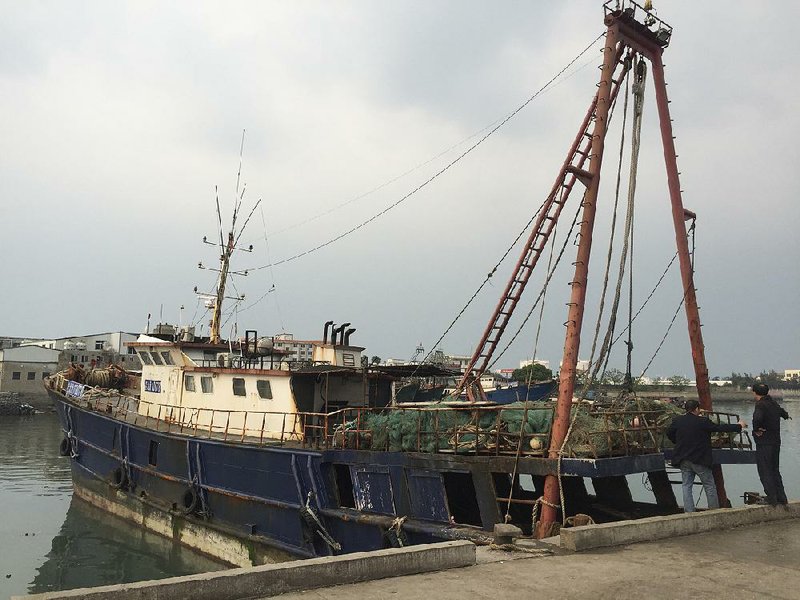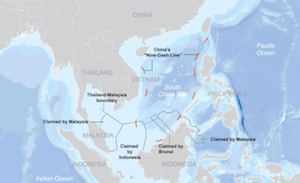BEIJING -- Evidence suggests that China is considering another bout of island-building in the South China Sea, and the United States administration and military already are on the alert.
Twice last week -- and again on Tuesday -- the U.S. Pacific Command said it sent warplanes close to Scarborough Shoal, a triangular chain of coral reefs, sand and rocks just off the coast of the Philippines.
The shoal is the latest point of friction between China, the United States and nations in the South China Sea region over Beijing's building of maritime outposts and other sites that could have potential future military use.
"Thunderclouds are gathering over the South China Sea, and China is the lightning rod," said Carl Thayer, emeritus professor at the University of New South Wales in Australia.
China seized the shoal from the Philippines in 2012, and appears to be considering whether to build an artificial island there, experts say. China already has constructed or reclaimed seven islands in the nearby Spratly Islands.
Work on the shoal would be another major step in cementing China's long-term control of the South China Sea, but it also would raise significantly regional tensions.
Driving the rising tensions is a key ruling by a panel of jurists at a United Nations-appointed tribunal in The Hague that is expected soon. Fearing an unfavorable ruling that could undermine its South China Sea claims, China could be considering a pre-emptive push to begin work on the shoal, known in China as Huangyan Island, experts speculate.
"It's believed that the rulings will be unfavorable to China and there are concerns that other countries like the United States and Japan will take this opportunity to further challenge China's territorial claims in the area," said Shi Yinhong, professor of international relations at Renmin University in Beijing.
He predicts China could respond by starting dredging work this year. There is circumstantial evidence to back up that argument.
In February, a plan to expand the shoal into an island containing a runway, harbor, town and resort surfaced on a Chinese website dedicated to military matters. Although a similar -- albeit less-detailed -- image had circulated in 2012, its recent reappearance was taken by some observers as a sign that the matter was being considered.
In March, the U.S. Navy chief, Adm. John Richardson, told the Reuters news agency the military had seen Chinese shipping activity around Scarborough Shoal, including possible survey work, suggesting it could be "the next possible area of reclamation."
On Monday, the South China Morning Post quoted an unnamed source "close to" the Chinese navy as saying China would carry out "land reclamation" on the shoal this year.
None of this is conclusive, experts warn.
Mira Rapp-Hooper at the Center for a New American Security said intense efforts were underway to dissuade China from taking a step that would be seen as "very escalatory" by the U.S.
It also would constitute a significant violation of a 2002 Declaration on the Conduct of the Parties in the South China Sea, experts said, although that agreement between China and rival Asian claimants has been ignored more often than observed.
"To my mind, it would be the final nail in that agreement's coffin," said Ian Storey, a senior fellow at the Institute of Southeast Asian Studies in Singapore.
China claims the vast majority of the South China Sea, and insists all disputes with rival claimants must be settled bilaterally.
But the Philippines took China to the Permanent Court of Arbitration after the seizure of Scarborough Shoal, insisting that China had breached international law.
In anticipation of the ruling, China has been active diplomatically, enlisting Russia's support for its position and on Tuesday reaching an accord with Indonesia on greater security and marine cooperation.
On Sunday, it also reached what it called an "important consensus" with Cambodia, Laos and Brunei that the dispute should not affect its relations with the Association of Southeast Asian Nations.
The U.S. has not been standing still either, recently announcing a permanent military presence on five bases in the Philippines and starting joint naval patrols in the South China Sea.
"Our job is to ensure air and sea domains remain open in accordance with international law," Air Force Col. Larry Card, commander of the Pacific Command's Air Contingent, said in a statement. "Free trade depends on our ability to move goods."
China says its actions pose no threat to commercial shipping, and accuses Washington of undermining regional peace and stability.
"Huangyan island is China's inherent territory and the Chinese military will take all necessary measures to safeguard national sovereignty and security," China's Defense Ministry said Monday.
"The United States is promoting militarization of the South China Sea in the name of 'Freedom of Navigation,'" the statement added.
Information for this article was contributed by Dan Lamothe, Emily Rauhala and Xu Yangjingjing of The Associated Press.
A Section on 04/28/2016

